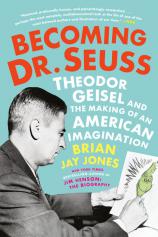Becoming Dr. Seuss: Theodor Geisel and the Making of an American Imagination
Review
Becoming Dr. Seuss: Theodor Geisel and the Making of an American Imagination
The man who became Dr. Seuss could well have become a mildly acclaimed political cartoonist, or simply an unknown, frustrated failure, but for a serendipitous meeting. In this thorough, thoughtful look at one of America’s best-loved children’s authors, Brian Jay Jones (JIM HENSON: The Biography, GEORGE LUCAS: A Life) reveals the many different aspects of this remarkable talent.
Having German origins in America, the wake of World War I may have stamped a certain cynicism on young Theodor Seuss Geisel, as he experienced the scorn and suspicion of his neighbors. In high school, he was a lackluster student but a brilliant cartoonist and humorist, a chief editor of the school magazine. Squeaking into Dartmouth College, Geisel continued to ride his reputation as a topical cartoon-smith, his acumen with words sufficient to grant him a chance at Oxford. He didn’t do well among the English, and at a certain point, he found himself writing ad copy, making a certain insecticide famous for his pithy slogan: “Quick, Henry! The Flit!”
"Jones creates an honest look at this complicated man who never had children of his own but liked the idea of helping youngsters delve into the world of reading with a smile."
Still, Geisel nourished a secret yen to write a children’s book. Inspiration came on a sea voyage, when the rhythm of the waves and his inner straining for an image brought forth what would be his first children’s work, AND TO THINK THAT I SAW IT ON MULBERRY STREET. When all attempts to sell the book seemed to have crashed, he fortuitously met an old friend on a walk down Madison Avenue, and was guided to Vanguard Press, which published the book in 1937. That led to more books written by “Dr. Seuss,” Geisel’s by-now-familiar pseudonym. During World War II, he turned his talents to political cartooning and a foray into documentary filmmaking for the military.
In the mid-’50s, Geisel was given a challenge: to transform children’s reading experiences at the most basic level, by composing a captivating story using only 350 words. Stymied at first, he finally seized on two words that could provide material for a story: a cat and a hat.
Jones creates an honest look at this complicated man who never had children of his own but liked the idea of helping youngsters delve into the world of reading with a smile. With many setbacks as successes, he gradually found solid ground in two artistic realms: simple rhymes with hilarious made-up creatures to speak them, and pictures of the creatures in delightful poses. Latterly accused of racism (MULBERRY STREET contained a caricature of an Asian character, for one major example), he can be seen, Jones believes, as a person of his times, with no special animus towards people of different races, and, aided in his career by two strong-minded women, no resentment towards smart girls. And the 1971 book THE LORAX, by contrast, shows Seuss’ radical grounding in his treatment of environmental issues.
BECOMING DR. SEUSS is a book that has been waiting to be written. It will provide a fascinating journey for adults of a certain generation who grew up and raised their children on the ever-evolving poems and pictures that sprang out of the fertile mind of Theodor “Dr. Seuss” Geisel.
Reviewed by Barbara Bamberger Scott on May 10, 2019
Becoming Dr. Seuss: Theodor Geisel and the Making of an American Imagination
- Publication Date: May 26, 2020
- Genres: Biography, Nonfiction
- Paperback: 496 pages
- Publisher: Dutton
- ISBN-10: 1524742791
- ISBN-13: 9781524742799




